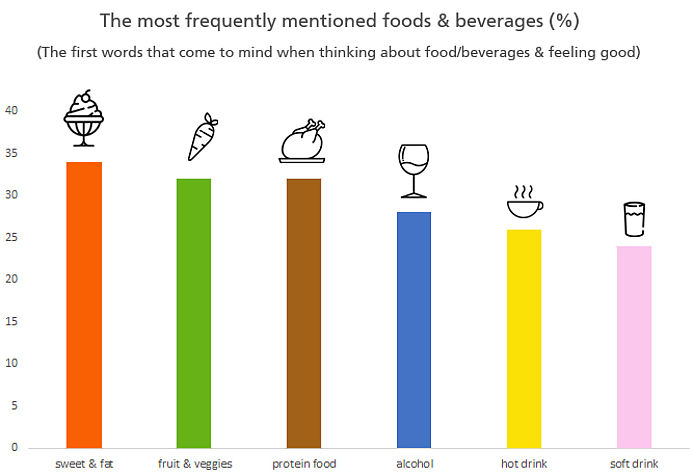Feeling good - first results of the ESN research project
Please scroll down for the longer version.
- video
- interactive online presentation (Prezi)
- publication (if you are interested in a copy, send us a mail)
Short version
One more time with feeling
A study spanning five continents shows that people the world over associate food and feeling good with ’tastes good’. However, when they think about the future, health and nutrition gain in salience. This reality could help change the direction of health programs and make them more functional and efficient.

Modern consumers are not just expecting the food to taste good and the beverages to be satisfying; eating and drinking should make you feel good too. The construct "feeling good" is a challenge for the sensory researchers and manufacturers who develop food and beverages. What does the consumer mean by feeling good? To answer the question, the European Sensory Network (ESN), an association of research institutes from 21 countries, took up the hunt by setting up a study spanning 14 countries on five continents.
The result: specific foods or beverages, such as ‘chocolate’, ‘wine’, ‘fruit’, ‘soda’, ‘beef’, ‘water’, as well as expressions related to tastes good, lead the list when it comes to food and the sense of feeling good. However, in some respects, countries also differed in their answers. For example, Norwegians often thought of fish when it came to eating and feeling good, Brazilians envisioned orange juice, Germans and French thought of water. Contrary to expectations, the English seldom came up with tea, and the Chinese rarely chose rice.
But there was one thing that united all nations. Even if layer cakes and steaks led the field when it came to a sense of feeling good in the present, when thinking about the future, feeling good was more often associated with healthier foods – especially fruit and vegetables. "Programs that promote a healthier diet can make use of the new findings and, for instance, focus on the consumers’ relating ‘feeling good’ to partaking in healthy food and drink as a way to influence present buying and consumption patterns." explains Claire Sulmont-Rossé, lead author of the study and Chair of the European Sensory Network.
Long version
Concerning eating and feeling good
It’s seven in the morning and my eyes are still half-shut. I spread some honey on my roll, take a sip of coffee, and pour a glass of orange juice. Am I full? Did it taste good? Sure thing. But there is another important question that tends to remain in the background: how did the breakfast affect how I feel? Did it make me feel good? This question not only tends to remain under the radar in everyday life; it has often been neglected by sensory researchers and food manufacturers, who tend to center on whether or not the consumer liked the product.
Over the last years, consumers have begun concentrating on well-being as an important aspect of their purchases, and thus, manufacturers have also taken notice. A product must not only please the consumer; it also needs to increase their sense of well-being. Eating and a sense of well-being simply belong together. That’s why sensory and consumer researchers are taking a closer look at this aspect.
However, the sense of well-being turns out to be not so easy to gauge. What do people mean when they use the term? Does that meaning vary from culture to culture? These questions were raised by the members of the European Sensory Network at their 2015 meeting in Naples, Italy. Challenges already began with the translation of well-being, as the languages of ESN members from 21 countries now had to be considered. For instance, how does one translate well-being into German? “With the somewhat old-fashioned word Wohlbefinden,” says Prof. Klaus Dürrschmid of the University of Vienna, Austria, “but does the word really fit?” And German was not the only language that had problems finding a single word that fit hand-in-glove with “well-being”.

These were fascinating questions, and ESN decided to search for the answers. Members put the topic on the agenda at the ESN meetings in Reykjavik, Iceland and Berlin, Germany. They invited experts to give lectures on well-being, including such authorities on the subject as Gaston Ares, Arnaud Aubert and Herb Meiselman. In the discussions that followed, it became clear that we know far too little about how food and beverages affect our sense of well-being. Research in this area needs to get back to the basics: what is peoples’ sense of well-being when they think about food and drink? Are there differences between the various countries?
These questions generated a research idea; a core team from eight countries, including representatives from national research institutes, universities, sensory research companies and industry developed a study design and presented it to the membership at the next ESN meeting. After lengthy discussions, ESN members decided to replace the hard-to-translate word well-being with the more universal term ‘feeling good’. The study’s lead author, ESN Chair Claire Sulmont-Rossé stressed that, “the two terms are not interchangeable, but feeling good is one of the dimensions that contributes to well-being.”
14 countries under the microscope
8,325 people from 14 countries took part in the study. The survey was conducted in ten languages. The following countries were included: France, Germany, Italy, Norway, Poland, Spain, United Kingdom, Australia, Brazil, China, India, Russia, South Africa and the USA. Market research agencies recruited around 600 participants per country. These were the tasks of the online survey:
1. Write down the first four words that come to mind when you think of food, drink and feeling good.
2. List four foods or drinks that make you feel good.
3. List four ways in which food and drink will make you feel good in the future.
A coding team covering all the languages evaluated the answers and divided them into 81 categories and eight dimensions. For example, the coders assigned the words ‘apples and beans’ to the category ‘fruit and vegetables’, words like ‘happy’ and ‘relaxed’ to the dimension ‘emotion’.
Question 1: The first four words
What four words first came to the minds of respondents when they thought about food, drink and well-being? Just to give a glimpse into the answers, here are some examples. According to a 26-year old woman from India, laddu (Indian sweet), semya (Indian noodles), puri (deep fried bread), and sambar (lentil sauce) make her feel good. A 22-year old man from South Africa wrote down chocolate, coffee, lasagna and pizza. A 37-year old woman from France listed panaché (beer plus lemonade), jambon cru (raw ham), salade de thon (tuna salad), and cote d´agneau (lamb chop).

When participants were asked to write down the first four words that came to their mind when thinking about food/beverages and feeling good, 62% named at least one specific food or beverage. The names ranged from foods that were sweet and/or fatty, alcohol, fruit and vegetables, to soft drinks and protein foods. Among the other dimensions, sensory and hedonic properties of foods were most often mentioned. The most relevant category within this dimension was tastes good, for example ‘delicious’ and ‘yummy’. It was mentioned by almost a quarter of the participants across all countries, and showed a particularly strong relevance among Chinese participants, who cited it over 70% of the time.
Russia, India, and the United Kingdom also gave tastes good a higher than average rating. Non-sensory properties also played a role in the participants’ sense of ‘feeling good’. However, this dimension covers a large number of product characteristics such as natural, unspoiled, inexpensive, good quality, and home-made. Finally, participants mentioned the effects of consuming foods and beverages on their emotions and health. Within the emotional dimension, the most frequently used words were happy, enthusiastic, satisfied, peaceful, and entertained.
In the dimension body and health, the most frequently mentioned categories were health, satiation, thirst, hunger, and being active. In summary, participants reported a wide range of associations when thinking about food and beverages and feeling good, which suggests the multi-dimensional nature of the construct. “In previous studies, the well-being construct included five dimensions: the physical, emotional, social, intellectual, and spiritual”, emphasizes Gaston Ares of the University of Uruguay, one of the authors of the study. “However, in the ‘feeling good’ ESN study, only three of these dimensions were included: the emotional, physical, and social dimension. It signifies that these three dimensions are more important when it comes to eating and drinking.”
Question 2: which foods and beverages make people feel good?
Across all 14 countries, sweets and fatty foods placed first (34%) for their feel-good factor, with fruit and vegetables, as well as high-protein foods, i.e. meat, fish and eggs in close second (32% each). Among drinks, alcohol came first (28), closely followed by hot drinks, such as coffee, tea, and hot chocolate (26%); soft drinks came third (24%).

A detailed look reveals clear differences between the countries. In Poland and Russia, for example, approximately half of the participants marked sweet and fatty foods and hot beverages as producing the ‘feel good’ effect. For participants from Norway and South Africa, on the other hand, protein-rich foods were in first place (approx. 54%). Products containing starch were frequently on the list in such countries as Italy, India, Brazil and Spain (35%-41%).
The Brazilian participants also stood out in their frequent mention of fruit, vegetables, and fruit juice (approx. 36%). Four countries, France, Germany, Italy and Norway, associated feeling good with water more often than others. Participants from Australia, Poland, Russia and United Kingdom United Kingdom associated alcohol with feeling good more frequently than participants from other countries.
However, some expected associations failed to materialize. For example, the word tea rarely came to the minds of United Kingdom participants, and in China the word rice seldom appeared in connection with feeling good. Question 3: what about the future? Participants had different expectations as to what foods would make them feel good in the future.
Fruit and vegetables garnered first place (13%) and fast food last place (4%). In fact, health and nutrition-related aspects were more salient for consumers when they were asked to think about how foods and beverages would make them feel good in the future rather than at present. The association between "healthy nutrition" and "feeling good in the future" was particularly clear in four countries: Australia, South Africa, the USA and United Kingdom (approx. 23%). High-protein foods stood out among the Chinese participants. Water was particularly important for Germans, and for Italians, "natural" foods stood out. When thinking about the future healthy options become more attractive.
Delicious and happy in the here and now, healthy when thinking about the future
It is known from earlier studies that emotional aspects play more of a role in the connection between feeling good and eating and drinking than do such abstract concepts as healthy and nutritious. The picture changes when people are asked what could contribute to their sense of feeling good in the future; then, physical and health-related aspects come into focus. While almost a quarter of those surveyed associated "tastes good" with feeling good when there was no reference to the future, this was the case for only 12% of the participants when it came to feeling good in the future.
When it comes to food and beverage preferences, emotional aspects are normally much more important to consumers than health aspects. This should be reflected in the design of measures that encourage people to eat healthier foods.
"The majority of the campaigns emphasize health and neglect the feeling and enjoyment of eating and drinking," warns Valérie Lengard-Almli of the Norwegian company Nofima. For manufacturers, this means that healthy products must not only be healthy in order to convince consumers; they must also trigger positive feelings, and above all, they must taste good. “This is certainly not an easy task", explains Claire Sulmont-Rossé, "but it’s a task to which sensory researchers can contribute their knowledge".
The text is based on the ![]() publication: A cross-cultural perspective on feeling good in the context of foods and beverages Food Research International 2019, Volume 115, Pages 292-301 Claire Sulmont-Rossé, Rafal Drabek, Valérie L. Almli, Hannelize van Zyl, Ana Patricia Silva, Martin Kern, Jean A. Mc Ewan, Gastón Ares
publication: A cross-cultural perspective on feeling good in the context of foods and beverages Food Research International 2019, Volume 115, Pages 292-301 Claire Sulmont-Rossé, Rafal Drabek, Valérie L. Almli, Hannelize van Zyl, Ana Patricia Silva, Martin Kern, Jean A. Mc Ewan, Gastón Ares
Text: Fabienne Hübener, Photos: stock photos from unsplash.com, ESN team by Klaus Duerrschmid